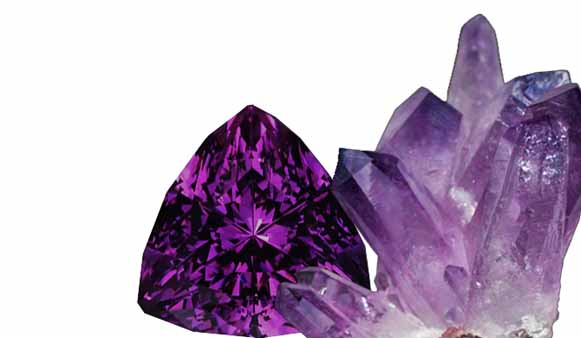Unfortunately it has become a gem that is often thought of as “old fashioned”, “dull”, “boring” and “common”. But, is actually a very beautiful, vivid stone – “the essence of purple” that has captured our hearts for hundreds of years!
Amethyst is a purple variety of quartz that is found in many locations around the world and forms as terminated crystals of all sizes inside geodes, clusters and as long single terminations.
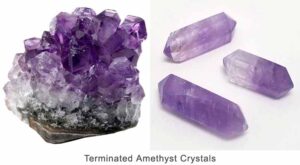

Some geodes (hollow, crystal lined bubbles) are big enough for a person to stand in! The largest Amethyst geode, The Empress of Uruguay, originally discovered in the Artigas region in northern Uruguay and transported to the Crystal Caves in Atherton, Australia, stands a staggering 3.27 meters tall and weighs 2.5 tonnes!
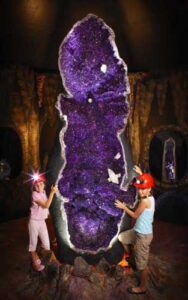
The name Amethyst comes from the Greek – méthystos (“intoxicated”), a reference to the belief that the stone protected its owner from drunkenness. It gets it wonderful purple coloring from Iron or Manganese compounds in the host rock and is often routinely heated to bring out a deeper purple color. It is the deeply saturated, strong purple color that is the most coveted.
Amethyst was as expensive as Emerald or Ruby until the 19th Century when large deposits of it were discovered in Brazil. Today it is the most valued of the Quartz family and is found in Russia, Brazil, Uruguay, Madagascar, Zambia and parts of the United States.
A little bit of history about Amethyst
° The Ancient Greeks wore Amethyst as amulets and made drinking vessels decorated in them to prevent themselves from being intoxicated.
° In the Middles Ages it was considered as a symbol of royalty and a “cardinal gem” and was used to decorate English regalia.
° Medieval European soldiers wore Amethyst amulets to protect them in battle.
° The Ancient Egyptians used Amethyst to guard against fearful and guilty thoughts.
° An Amethyst is the ninth stone in the Breast Plate Of Aaron – worn by the high priest of Israel, and one of the ten stones upon which the names of the tribes of Israel were engraved.
° The ancient saint St. Valentine, the patron of love, wore an Amethyst ring carved with a cupid. Hence, why it is also the birthstone for February.
° Tibetans have always considered Amethyst to be sacred to the Buddha and make prayer beads from it.
FAMOUS AMETHYSTS
The Delhi ‘Sapphire’ – is actually an Amethyst. It was incorrectly identified in the nineteenth century. It is said to be cursed since it was looted from a temple in Kanpur, India, during the bloody Indian Mutiny of 1857. It is now in the collection of the Natural History Museum in London.

The Tiffany Amethyst Necklace. A 56 carat square cushion cut Amethyst delicately surrounded by vines, leaves and grapes, designed by Louis Comfort Tiffany, circa 1915. Procured by George F. Kunz, chief gemologist at Tiffany’s at the time. It is a much larger and of higher gem quality than any others in the National Gem Collection from this Russian locality. It was then generously donated to the Smithsonian in 2007.
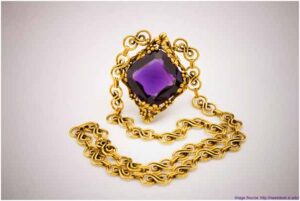
The Morris Amethyst Brooch – made most likely during the Edwardian period and features a spectacular 96 carat heart shaped Amethyst surrounded in Diamonds and set in platinum and yellow gold. It was donated to the Smithsonian Institution by Mrs. M. Morris in 1973 and is now on display at the National Museum of Natural History in Washington.
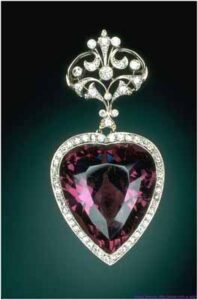
BIRTHDAYS AND HIGH DAYS
Amethyst is the February birthstone and celebratory gem for the 6th and 17th Wedding Anniversary.
AMETHYST’S HEALING AND SPIRITUAL MEANINGS
° Amethyst crystals are exceptional for providing spiritual protection, inner strength and clarity of mind, making them a classic meditation tool.
° Amethysts healing properties also include acting as a natural form of stress relief and attracts positive energy while ridding your body of any negative emotions, they are said to help strengthen the immune system and heal any imbalances that lie in the body.
° They are said to be beneficial to your environment, working to purify any space of negative vibrations.
Color Psychology – Purple
Creativity, Wealth, Serenity, Contemplative.
AMETHYST JEWELRY
Amethyst has been used in jewelry for centuries, and being a durable gemstone it can be used to form all types of jewelry. Ranging in color from a subtle pale pastel to a gorgeous, rich velvety deep purple they can be easily set in all colors of gold

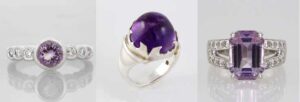

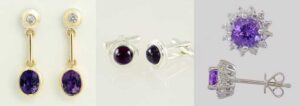
A truly gorgeous purple gemstone and one that will reign on into the centuries



